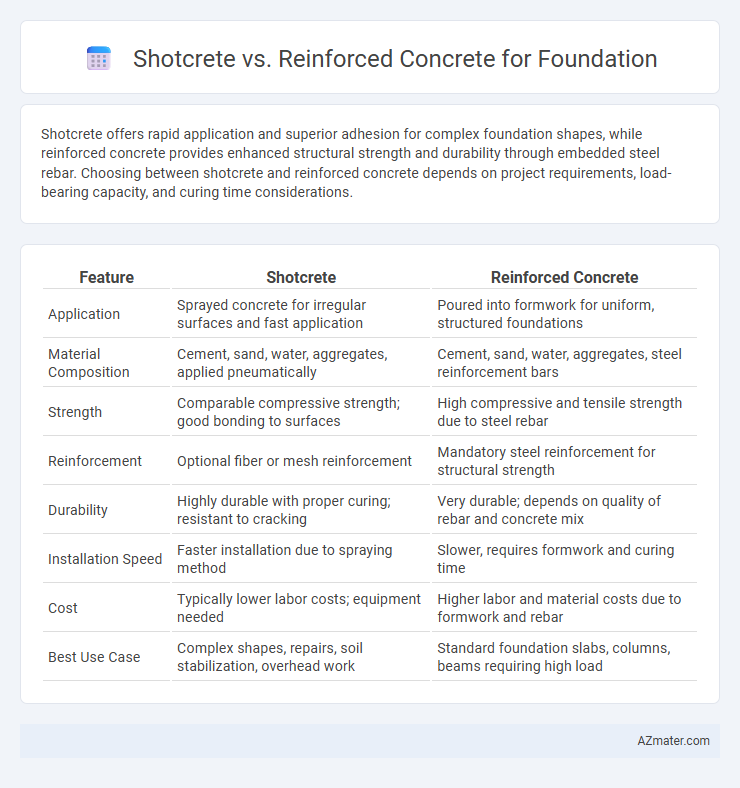Shotcrete offers rapid application and superior adhesion for complex foundation shapes, while reinforced concrete provides enhanced structural strength and durability through embedded steel rebar. Choosing between shotcrete and reinforced concrete depends on project requirements, load-bearing capacity, and curing time considerations.
Table of Comparison
| Feature | Shotcrete | Reinforced Concrete |
|---|---|---|
| Application | Sprayed concrete for irregular surfaces and fast application | Poured into formwork for uniform, structured foundations |
| Material Composition | Cement, sand, water, aggregates, applied pneumatically | Cement, sand, water, aggregates, steel reinforcement bars |
| Strength | Comparable compressive strength; good bonding to surfaces | High compressive and tensile strength due to steel rebar |
| Reinforcement | Optional fiber or mesh reinforcement | Mandatory steel reinforcement for structural strength |
| Durability | Highly durable with proper curing; resistant to cracking | Very durable; depends on quality of rebar and concrete mix |
| Installation Speed | Faster installation due to spraying method | Slower, requires formwork and curing time |
| Cost | Typically lower labor costs; equipment needed | Higher labor and material costs due to formwork and rebar |
| Best Use Case | Complex shapes, repairs, soil stabilization, overhead work | Standard foundation slabs, columns, beams requiring high load |
Introduction to Shotcrete and Reinforced Concrete
Shotcrete is a method of applying concrete projected at high velocity onto surfaces, often used for foundation repair and slope stabilization due to its rapid curing and superior adhesion. Reinforced concrete combines concrete with embedded steel bars or mesh, enhancing tensile strength and durability for foundational structures exposed to heavy loads. Both materials offer unique advantages, with shotcrete providing flexibility in shape and speed, while reinforced concrete delivers robust, long-lasting support.
Key Differences Between Shotcrete and Reinforced Concrete
Shotcrete and reinforced concrete differ primarily in their application methods and structural properties; shotcrete is pneumatically sprayed onto surfaces, allowing for faster placement and better adherence to complex shapes, while reinforced concrete is typically poured into forms and requires time to cure. Shotcrete offers superior bonding capabilities and is ideal for repair or irregular surfaces, whereas reinforced concrete provides consistent strength and is preferred for large-scale, uniform foundation slabs. The choice between the two depends on project requirements such as shape complexity, application speed, and structural demands.
Application Methods in Foundation Construction
Shotcrete involves spraying a high-velocity mixture of concrete onto surfaces, enabling rapid application and strong adhesion to complex foundation shapes, making it ideal for excavation support and slope stabilization in foundation construction. Reinforced concrete requires formwork and steel reinforcement placement before pouring the concrete mixture, providing robust structural integrity essential for load-bearing foundation elements such as footings and slabs. The application method of shotcrete offers flexibility and speed in irregular or confined areas, whereas reinforced concrete emphasizes precision and strength through controlled casting processes.
Strength and Durability Comparison
Shotcrete offers superior adhesion and rapid application, resulting in excellent compressive strength and enhanced durability for complex foundation geometries. Reinforced concrete, with embedded steel rebar, provides exceptional tensile strength and long-term structural integrity, making it ideal for heavy-load-bearing foundations. Both materials deliver high durability, but reinforced concrete generally outperforms shotcrete in resistance to cracking and structural fatigue over time.
Cost Analysis: Shotcrete vs Reinforced Concrete
Shotcrete offers a cost advantage over reinforced concrete by reducing labor and formwork expenses due to its spraying application method, which accelerates construction timelines. Reinforced concrete typically incurs higher material and labor costs, driven by the need for extensive formwork and manual placement of steel reinforcement. Evaluating project-specific factors such as foundation size and site accessibility is crucial, as shotcrete can lower overall costs in complex or confined spaces compared to traditional reinforced concrete methods.
Installation Speed and Efficiency
Shotcrete offers significantly faster installation speed for foundations compared to traditional reinforced concrete due to its sprayed application method, which eliminates the need for extensive formwork and reduces labor time. The efficiency of shotcrete lies in its ability to conform tightly to complex shapes and irregular surfaces, ensuring quick curing and immediate structural support. Reinforced concrete requires longer setting times and more intensive preparation, making shotcrete a preferred choice for projects with tight schedules and demanding site conditions.
Flexibility in Design and Usage
Shotcrete offers superior flexibility in design and usage due to its ability to be applied pneumatically on complex shapes and irregular surfaces, allowing for rapid construction and reduced formwork. Reinforced concrete requires more rigid formwork, limiting its adaptability but providing excellent structural strength and durability for foundational support. Shotcrete's adaptability makes it ideal for repair work and intricate foundation designs, while reinforced concrete suits large-scale, uniform foundation structures.
Common Challenges and Limitations
Shotcrete faces challenges in achieving uniform thickness and compaction, which can lead to weak spots and reduced durability in foundation applications. Reinforced concrete often encounters issues with corrosion of steel reinforcement, impacting long-term structural integrity. Both methods require meticulous quality control to prevent cracking and ensure proper bonding with the foundation substrate.
Best Use Cases for Each Material
Shotcrete excels in complex foundation repairs and applications requiring rapid placement in confined spaces or irregular shapes, offering high adhesion and reduced formwork. Reinforced concrete is ideal for large structural foundations demanding superior compressive strength and durability, especially where heavy loads and long-term stability are critical. Selecting between shotcrete and reinforced concrete depends on site conditions, load requirements, and project timelines to optimize performance and cost-efficiency.
Conclusion: Choosing the Right Solution for Foundations
Shotcrete offers rapid application and excellent adherence, making it ideal for complex or irregular foundation shapes, while reinforced concrete provides superior structural strength and durability for large-scale or heavily loaded foundations. The choice depends on project requirements, including load capacity, site conditions, and construction timeline, with reinforced concrete favored for traditional, high-load foundations and shotcrete preferred for fast, versatile installations. Evaluating specific engineering needs and environmental factors ensures selecting the most effective foundation method that balances cost, performance, and longevity.

Infographic: Shotcrete vs Reinforced Concrete for Foundation
 azmater.com
azmater.com